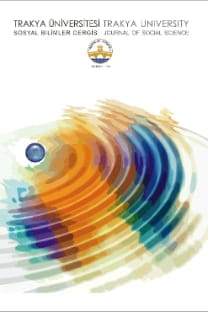SANATTA LEDA VE KUĞU TEMASI İLE KOLEKTİF BİLİNÇDIŞI İLİŞKİSİ ÜZERİNE
Bu çalışmada Yunan Mitolojisinde yer alan Leda ve Kuğu teması, sanata yansımaları ve kolektif bilinçdışıyla ilişkileri incelenmektedir. Farklı zamanlarda çok sayıda sanatçının konuya gösterdiği ilginin psikolojik nedenleri sorgulanmaktadır. Mitoloji ve sanatta yer alan benzer imgelerin kişisel ve kolektif bilinçdışıyla ilişkisi olduğu ileri sürülmektedir.Leda ve Kuğu hikayesinde Leda ile kuğu, kolektif bilinçdışından türeyen birer metafor olarak, kadın-erkek ilişkilerine, insanlığın cinselliğe dair arzu, korku ve duyguların biçim değiştirerek estetik imgelere dönüşmüş biçimiyle sanatçıların ilgisini çekmiştir. Ayrıca temanın sanata konu olmasında metaforların zengin içeriği ile Leda ve kuğudan oluşan iki formun içe içe geçen kapalı kompozisyonunun biçimsel formunun da etken olduğu düşünülmektedir. Gerek kişisel psişenin, gerekse toplumun ortak bilinçdışından gelen tabu, korku veya fantezilerin, tıpkı rüyalarda biçim değiştirerek ifade bulması gibi, evrensel bilinçdışından gün yüzüne çıkmak için metaforlara dönüşerek kendine bir ifade yolu bulduğu belirlenmiştir. Bu nedenle, her sanatçı kendi farklı yaşantı deneyimlerinden, başka bir deyişle kişisel bilinçdışının müdahalesi dolayısıyla temayı farklı yorumlamışlardır. İnsanlığın kolektif bilinçdışında yer alan arketipler olarak Leda ve kuğunun durumu, genel olarak kadın erkek ilişkilerine dair cinsel göndermelere yönelik bir anlam taşırken, kişisel bilinçdışının etkisiyle, Leonardo da Vincide annelik rolü; Michelangeloda fiziksel bir tutkuyla kendinden geçişi, mest olma durumunu; Leda tek başına ızdırap içinde can çekişmeyi; Boucherde erotik çağrışımları ve kuğunun boynu ile fallik göndermeyi simgelediği belirlenmektedir.
ON THE RELATIONSHIP BETWEEN THE LEDA AND THE SWAN THEME IN ART AND THE COLLECTIVE UNCONSCIOUS
In this study, Greek mythology originated theme the "Leda and the Swan", its' reflections on art and the relationship between thema and the collective unconscious is analyzed. The psychological reasons for the interest of a number of artist's in the subject in various times is questioned. It is argued that similar images in the mythology and art is associated with personal unconscious and collective unconscious. As a metaphor, derived from collective unconscious, Leda and swan in the story of "Leda and the Swan" has attracted attention of artists in the form of relationships between male and female, about sexual desire, fear and emotions of humanity that morphing in the way that transformed into aesthetic images. In addition, it is considered that it is the formal form of closed composition of nested two forms of Leda and the swan and substantial content of the metaphors is efficient. It is determined that taboos, fears or expressions which arising from both personal psyche and society's colective unconscious, in order to emerge on surface from the colective unconscious, it attains a way for expression converting into metaphors such as in dreams converting into another form in order to expressing. Therefore, each artist has different interpretations of the theme on account of their different experience or in other words, owing to intereference of personal unconscious. As archetypes that originated in the collective unconscious mind of humanity, the status of Leda and the swan, while implying sexual referring oriented in general that concerning the relationships between men and women, due to the impact of the personal unconscious, it is determined that it symbolizes maternity in Leonardo da Vinci's painting; symbolizes a status of being enchanted or ecstasy with a physical passion; Leda, single by herself, symbolizes moribundity in agony in Michelangelo's painting; and with the long necked swan, it symbolizes erotic connotations and phallic references in Boucher's paintings.
___
- Arnheim, R. (2009). Görsel Düşünme. (çev:Rahmi Öğdül). İstanbul: Metis Yayınları.
- Barker, P. Using Metaphors in Psychotherapy, Brunner/Mazel Inc., New York 1985, s. 6.http://www.google.com.tr/books?hl=tr&lr=&id=E-QPCvLAuXQC&oi=find&pg=PR7&dq=leda+and+the+swan+&ots=b6jrfORZ3p&sig=6X83kcpf276ungxNn2rIAm3iEyw&redir_esc=y#v=onepage&q=leda&f=false (04.01.2015).
- Barnwell, W. C. The Rapist in Leda and the Swan, South Atlantic Bulletin, Vol. 42, No. 1, Jan., 1977, pp. 62-68. http://www.jstor.org/discover/3199055?sid=21105657054833&uid=4&uid=2 (26.12.2014)
- Birke, L. (2013). Pictures in an Exhibition: An exhibition of digital video. Master of Fine Arts, Studio Art. University of Waterloo Art Gallery, Waterloo. http://www.lisabirke.com/writings/pdfs/lisabirke_thesissupportdocument_2013.pdf (20.01.2015)
- Corbin A., Courtine J., Vigarello G. (2008), Bedenin Tarihi: Rönesanstan Aydınlanmaya, (çev:Saadet Özen) 1.Baskı, Yapı Kredi Yayınları, İstanbul.
- Cömert, B. (1999) Mitoloji ve İkonografi. Ankara: Ayraç Yayınevi.
- Draper, J. D. For the Love of Leda The Metropolitan Museum of Art Bulletin, New Series, Vol. 30, No. 2 (Oct. - Nov.,1971), pp. 50-58
- http://www.jstor.org/discover/3258603?sid=21105653195813&uid=2&uid=4 (19.01.2015) Erhat, A. (2011). Mitoloji Sözlüğü. İstanbul: Remzi Kitabevi.
- Eyüpoğlu, H. Cinsel Taciz ve Travma: Eleştirel Bir Deneyim Aktarımı, Eleştirel Psikoloji Bülteni, Sayı 1, Mart 2008, s:61-68 http://elestirelpsikoloji.org/wp-content/uploads/2014/11/61-68-Eyupoglu.pdf (19.01.2015)
- Freud, S. (1979) Sanat ve Sanatçılar Üzerine, (çev:Kamuran Şipal), 1.Baskı, İstanbul: Bozak Yayınları.
- Freud, S. (2014). Rüyaların Yorumu. (çev:Dilman Muradoğlu). 1. Baskı (Tam Metin), İstanbul: Say Yayınları.
- Horney, K. (1993). Kadın Psikolojisi. (çev:Selçuk Budak). 3.Basım, Ankara: Payel Yayınevi.
- http://museum.cornell.edu/earthlyparadise/bos.html (21.01.2015)
- http://notesdemusees.blogspot.com.tr/2011/11/chateau-thierry-la- fontaine.html(04.01.2015)
- http://spot.colorado.edu/~minorv/arth439images.htm/boucher%20leda%20swan.jpg (21.01.2015)
- http://www.ancientworlds.net/aw/Post/1205393 (13.01.2015).
- http://www.bc.edu/bc_org/avp/cas/his/CoreArt/art/anc_bou_leda.html(04.01.2015).
- http://www.jstor.org/stable/462642 (26/12/2014)
- http://www.nationalgallery.org.uk/paintings/after-michelangelo-leda-and-the-swan (04.01.2015)
- http://www.theoi.com/Heroine/Leda.html (27.12.2015).
- Jung, C. G. (2006). Analitik Psikoloji, (Çev. Ender Gürol), 2. Basım, Payel Yayınları, İstanbul .
- Jung, C. G. (2013). Dört Arketip, (Çev. Zehra Aksu Yılmazer), 4. Basım, Metis Yayınlar, İstanbul.
- Poundstone, W. How Do You Paint an Orgasm? (August, 2012) http://blogs.artinfo.com/lacmonfire/tag/norton-simon/(13.01.2015)
- Rosenthal, M. ve Yudin, P. (1972). Materyalist Felsefe Sözlüğü (çev.Aziz Çalışlar). Sosyal Yayınlar, İstanbul.
- ISSN: 1305-7766
- Yayın Aralığı: Yılda 2 Sayı
- Başlangıç: 2000
- Yayıncı: Trakya Üniversitesi Sosyal Bilimler Enstitüsü
Sayıdaki Diğer Makaleler
MÜZE, KÜTÜPHANE VE ARŞİV BİNALARINDA AFETLERE YÖNELİK TEDBİRLER
KPSS ALMANCA ÖĞRETMENLİK ALAN BİLGİSİ TESTİ HAZIRLIK MATERYALLERİNE ELEŞTİREL BİR BAKIŞ
Sevinç SAKARYA MADEN, Harun GÖÇERLER
RAŞİD DİVANI’NDA TOPLUM VE KÜLTÜR
AKRAN İŞBİRLİĞİ VE İLK OKUMA YAZMA ÖĞRETİMİ
Emel GÜVEY AKTAY, Mehmet GÜLTEKİN
ENGELLİ ÇOCUĞA SAHİP AİLELERİN YAŞAM KALİTESİNİN İNCELENMESİ
Harun CANARSLAN, Emine AHMETOĞLU
SOSYAL AĞ KULLANICILARININ BİLİŞSEL KAPILMA DÜZEYLERİ
Özcan Özgür DURSUN, Cem ÇUHADAR
SANATTA “LEDA VE KUĞU” TEMASI İLE KOLEKTİF BİLİNÇDIŞI İLİŞKİSİ ÜZERİNE
